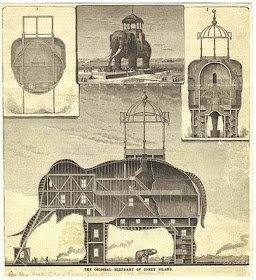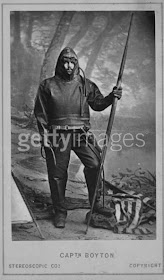I hasten to point out that the four men who sought shelter at the Sheepshead Bay Inn, that stormy November afternoon, were not criminal masterminds. It turns out they were not masterminds of any kind. But then, how many people are masters in any line of work? The lead voice in this quartet was Charles Gibbs, a diminutive thirty-six year old fire plug - and the last pirate in New York City who did not work on Wall Street. His Achilles in crime was the baritone Thomas Wansely, a tall and powerfully built black man, too curious by half. The bass was voiced by Robert Dawes, cook and nonentity, a plump man with no criminal record, as of yet. But tenor lead singer was John Brownrigg. He possessed a fatal combination of greed and a conscious, which caused him to first commit a horrible crime and then to confess to it unbidden to a complete stranger.
Perhaps it was the warm food, on that stormy Wednesday afternoon of 24 November, 1830. Or maybe it was the hot rum they imbibed. Or perhaps it was the flames of purgatory which John Brownrigg saw flickering in the hearthstone. But something drove Mister Brownrigg to draw innkeeper Samuel Leonard aside and spill a tale of betrayal, murder and piracy. Just weeks earlier, explained John, the four men taking refugee this day and two others had been crewmen of the small brig Vineland, Captained by William Thornsby. They were docked at Vera Cruz, Mexico, freshly loaded with a cargo of cotton bales, and casks of molasses and rum.Late in the day crewman Thomas Wansely had been ordered by Captain Thornby to stack a half dozen heavy barrels in the captain's quarters. The strain and curiosity drove Wansely to pry open one of the leaden barrels for a peek. Inside he found newly minted silver coins – Mexican pieces of eight. And as the tide pulled the Vineland into the Gulf of Mexico, Wansely shared his discovery with first mate Charles Gibbs.
By Gibb’s figuring the barrels together held today’s equivalent of over one million dollars in untraceable cash. It was untraceable because, without a standardized national currency of their own, Spanish and Mexican coins circulated so commonly in America, that prices were figured as the equivalent in Spanish (and Mexican) currency, to the point that today’s ubiquitous American dollar sign (“$” ) was borrowed from its Spanish inventors.
In the morning, Gibbs and Wansely opened one of the barrels of rum and shared the contents with Dawes, Brownrigg and the two other crewmen. And once they were all well intoxicated, Gibbs told them of the cargo of silver, and confessed that the night before he had thrown Captain Thornby overboard. With that much money at stake, explained Gibbs, they were now all under suspicion of murder. So, Gibbs suggested, why not share the crime and the silver between them. One crewman balked and joined the captain in the briny deep. The others quickly agreed to become pirates. As the vessel crossed the gulf bound for New York, a second man sobered up and expressed regret. He joined his fellow law abiding mate in the cold, heartless sea.
Their doubts thus drowned, on Tuesday, 23 November, 1830 the Vineland reached the westernmost barrier island off New York. Its name derives from the Dutch ‘Conyne Eylandt’, meaning Rabbit Island. They anchored in an isolated corner of Jamaica Bay. There, with a nor’easter brewing in the gathering darkness, the four men struggled to lower a skiff and fill it with their burdensome barrels of silver. They then scuttled the Vineland and set her afire. As she sank into the muddy waters of the bay the four men in the low riding skiff set off for shore, at what is today Rockaway Beach.
It was not beach weather. The surf was pounding. A gale was approaching. The landing was a disaster. In the crashing waves the four seamen lost most of their booty, and were able to save just 10% of the coins. Wet, cold and exhausted, soaked by a pounding downpour, the gang of four came to the realization they had not thought things through as well as they thought they had. While Wanesly and Brownrigg stood guard over what was left of their loot, Gibbs and Dawes walked to a tavern Gibbs was familiar with in the isolated village of Carnarsie.
The tavern was run by the Johnson brothers, John and William. It was the youngest, William, who answered the door that night. He recognized Gibbs and was willing to rent him a horse and wagon for an hour or so. Gibbs explained he had a heavy load to transfer from a boat.
Having thus obtained the tools required, Gibbs and Dawes returned to the beach, and, according to Brownrigg, the four men buried the remaining $56,000 in Mexican silver, marking the spot with a strand of ribbon tied to the saw grass. They then returned to Johnson’s pub and Gibbs paid for the rental with a generous bag of brand new Mexican coins.
The four men were headed for lower Manhattan, where they would claim the ship had been lost in the storm. Their convenient alibi was by now pounding the coast, and after having crossed Coney Creek, the quartet was forced to seek refuge in John Leonard’s Sheepshead Bay Inn, where John Brownrigg spilled his guts.
Inn keeper Samuel Leonard was nothing if not decisive. Quietly he gathered his staff and they fell upon the three villains. Well, two of the villains. Gibbs and Dawes were quickly tied to their chairs, but the tall powerful Wanesly broke for the woods, followed by the courageous waiter Robert Greenwood, who was armed with an unloaded flintlock pistol. An hour later Greenwood returned with Wanesly in tow.
The justice of the peace, John Van Dyck, was summoned, and next morning Brownrigg lead the authorities to the buried treasure. Only the treasure was not there. Under questioning Dawes decided to cooperate, and related again the tale of the visit to the Johnson brothers tavern. Under questioning both Johnsons confirmed the story, but, insisted, they knew nothing else. Van Dyck was certain that they did. And Van Dyck was correct.The instant Gibbs had crossed William Johnson’s palm with the newly minted silver, the mastermind was awakened in William Gibbs. Perhaps if the payment had been less generous, or if Gibbs had paid in any other currency, his secret might have remained secret. As it was, 19 year old William immediately woke his older brother John, and after examining their weary horse’s hooves and finding sand there, the brothers searched the beach. They quickly spotted the ribbon and found the cache of stolen silver. Which they promptly re-stole. They dragged it inland a few hundred yards, divided and re-buried it in two new caches, one of about $40,000 and the second of about $16,000. And then they returned home for a hearty breakfast.
JP Van Dyke suspected this, or most of it. But he could prove nothing. And once a beachcomber had discovered Mexican eights rolling around in the surf at Rockaway Beach, he was joined by hundreds of others combing the sand. After that there was no way of proving where the crazy eights had come from - the cache or the surf or maybe heaven above. Van Dyke could only choke the four birds he still had, in the Flatbush Jail.
And then something almost predictable happened. William Johnson began to have second thoughts. Or a glimmer of guilt. He approached the insurance company (yes, even in 1830 there were insurance companies), and inquired what they might pay as a reward for the return of some of the silver. The insurance company replied that they would be willing to make a generous settlement which might not leave the brothers filthy rich, but at least they would be free from worry of future legal entanglements. Encouraged, William returned to Rockaway Beach to confirm the security of both of the caches, whereupon he made a most distressing discovery. He could not trust his brother.
You see older brother John was married. And that meant yet another brain working on the possibilities of all that silver sitting quietly under the sand. Clearly John or his wife, or the pair together, had reached the conclusion that even though John had not heard opportunity knock, William had awakened him to it. The Johnsons thus became convinced they were deserving of the larger share of the stolen silver. So they took it, and disappeared. That left 19 year old William Johnson to return the remaining $16,000 in pieces of eight, in exchange for a greatly reduced reward.
On Friday, 22 April, 1831, on the site which would one day support the Statue of Liberty, criminal masterminds Charles Gibbs and Thomas Wansley climbed the thirteen steps of a scaffold, where they were both hanged by the neck until they were dead. Gibbs had been convicted of piracy, and was the last man hanged for that crime in America - so his death was not entirely without meaning. Wansley, the black man, died for the crime of murder. Dawes and Brownrigg served short jail terms, and disappeared from history. William Johnson lived in Brooklyn until 1906. He married and produced at least one son and a daughter. I have no evidence, either way, if they were masterminds like their father, and their long lost wealthy aunt and uncle.
But of those two remaining masterminds, older brother John and his wife, they escaped with a fortune in untraceable pieces of eight. Nothing more was ever heard of either of them, that we know of.Odd that such a fortune should disappear without a trace. But I I suspect that he or she later turned up dead. I say this because, on average, the percentage of successful pirates is usually pretty damn small.
-30 -




















































